Olympus E-510 Digital SLR Review
Olympus E-510 Digital SLR
The Four Thirds system grows up
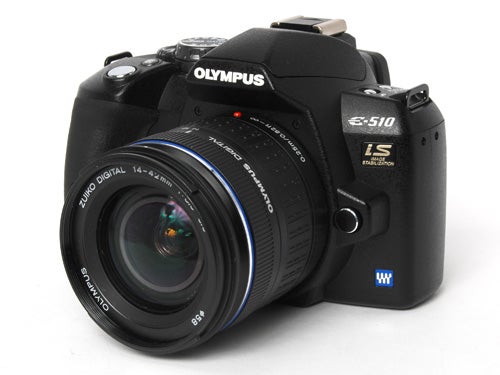
Verdict
Key Specifications
- Review Price: £599.00
When I first tried this new Olympus E-510 DSLR last week, I was initially puzzled by some of the noises it was making, which is unusual for me. I’ve been reviewing digital cameras for about ten years, and in that time I’ve handled and used hundreds of different cameras, from the earliest sub-megapixel snapshot models to the latest professional digital SLRs. I’m not bragging here (OK, maybe just a little), I’m just trying to explain that I’m pretty familiar with digital cameras, and that it takes a lot to surprise me.

Normally when you switch on a DSLR, nothing much happens. The monitor may activate displaying shooting data, or maybe the self-cleaning CCD mechanism will buzz briefly, but that’s usually about all. However from the E-510 I heard the distinctive sound of the reflex mirror flipping up immediately after I switched it on, normally something you only hear when taking a photo. I fiddled with it, switched it on and off a few times, and tried taking a picture. There didn’t seem to be any problems with that, but again there was the sound of the mirror flipping up, then down, then up again. I kept looking at the camera data and the scene through the lens on the monitor screen, and wondering if I had a faulty review sample. Then it dawned on me – the scene on the monitor… I’m so used to using compact digital cameras with live monitor views that it just didn’t strike me as unusual to be seeing the same thing on the E-510. But of course the E-510 is an SLR, and SLRs don’t have live view. Except this one does.
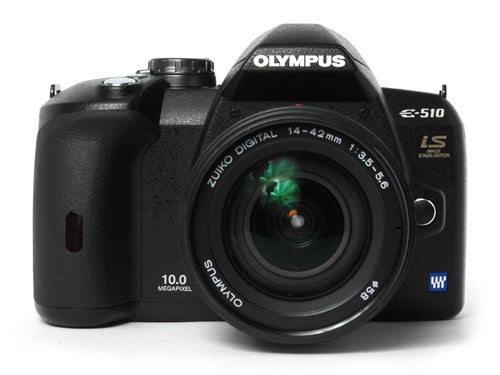
It was March of last year when I reviewed the 8-megapixel E-500, Olympus’s third E-system DSLR. I was impressed by its simple and compact design, beginner-friendly interface and superb handling, and especially by its very high picture quality and wide range of creative options. Like most people I had been expecting the E-510, as its model number suggests, to be little more than a 10-megapixel upgrade of the entry-level E-500, but in fact it is far more. The E-510 is a completely new camera, and aimed at a different sector of the market. In terms of design, specification and price (£599 with the 14-42mm f/3.5-5.6 ED kit lens), the E-510 is aimed instead at the semi-pro or advanced hobbyist, competing with the likes of the Canon EOS 30D (£649 with EF-S 18-55mm f/3.5-5.6), the Nikon D80 (£672 with AF-S DX 18-70mm) and the Pentax K10D (£499 with SMC DA 18-55mm).
The E-510 looks very different to the E-500. It looks a lot more like a traditional SLR, with a wide body that protrudes both sides of the lens mount. It’s not a huge camera by any means, in fact measuring 136 x 91.5 x 56 mm and weighing 460g body-only, it is considerably smaller and lighter than any of its immediate competitors, one of the big benefits of the made-for-digital Four Thirds system. Nonetheless it is a full-size SLR with a nice big handgrip, and it feels bigger than it is. The shape of the camera is quite functional, with plenty of straight lines and creased edges, but it is very secure and comfortable to hold. Build quality is superb, even better than the far-from-shabby E-500. The body is plastic, but over a metal chassis, and it feels very strong and robust, and capable of taking the bumps and knocks that it will receive in professional use. Although it lacks the environmental sealing of the Pentax K10D or more expensive models like the Nikon D200, the card and battery hatches are very tight fitting and dust ingress isn’t likely to be a major problem. As for moisture, I used the camera on a rainy day (are there any other kind?) at an outdoor event, and it didn’t appear to mind a few splashes.
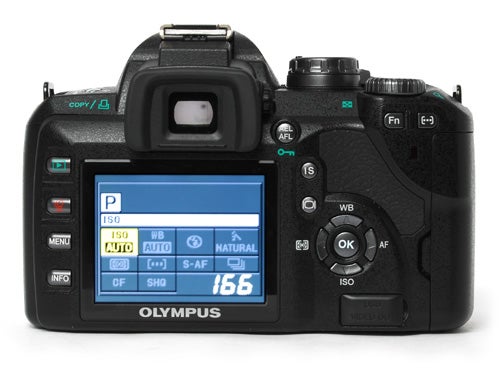
The control layout is a little daunting at first glance, with a large 11-position main mode dial and no fewer than seventeen buttons dotted around its surface, but everything is clearly labelled and logically laid out, and despite its complexity it is surprisingly intuitive, at least for anyone who’s handled a digital SLR or high-end superzoom before. ISO, white balance, AF mode, AF spot position, metering mode, image stabilisation mode, drive mode and AE/AF lock all have their own buttons, but as well as this the E-510 has the same on-screen quick menu system as the E-400 and E-500, providing a visual interface for all these functions as well. One nice feature is the Fn button, which by default operates as an one-touch manual white balance button, but can also be set to other options, including DOF preview, live preview, test picture or a user-defined picture mode.
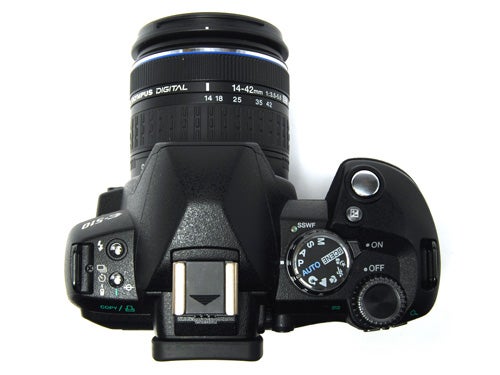
Even the huge array of external controls doesn’t begin to scratch the surface of just how much user control this camera offers. Virtually everything is either adjustable or optional. There are three different levels of noise filtering, or you can turn it off altogether. The compression rates and image size of the lower quality settings can be adjusted. The three pre-set picture modes can be tailored to your specifications of contrast, sharpness and saturation, and the monochrome mode has built-in red or green filtering and tone adjustment. Even the timer on the anti-shock mirror-up delay can be adjusted, and there’s much more. There aren’t many cameras on the market with such a complete menu and control system, and it is this more than anything sets that camera firmly apart from entry-level models such as the Canon EOS 400D or Nikon D40X.
The range of photographic controls is just as impressive. Shutter speeds from 60 seconds to 1/4000th are available, and the kit lens offers maximum apertures of f/3.5-5.6 and minimum aperture of f/22, both incremented in a choice of 1EV, 1/2EV or 1/3EV steps. The ISO settings of 100-1,600 are only incremented in 1EV steps, but with adjustable noise control this is a benefit rather than a handicap. Like the E-500, the E-510 offers a massive +/- 5EV of exposure compensation in all auto-exposure modes, and where most cameras are content with evaluative, centre-weighted or spot metering, the E-510 also offers spot metering for shadows or highlights as well, so there’s really no excuse for a badly exposed picture. Unlike some other high-end DSLRs the E-510 only has a single adjustment wheel, so in full manual mode the +/-EV button is held down to adjust aperture. This will undoubtedly cause howls of mocking laughter on various forums, mainly from Nikon D80 owners, but to be honest if you’re used to a one-dial system it’s really not a problem.
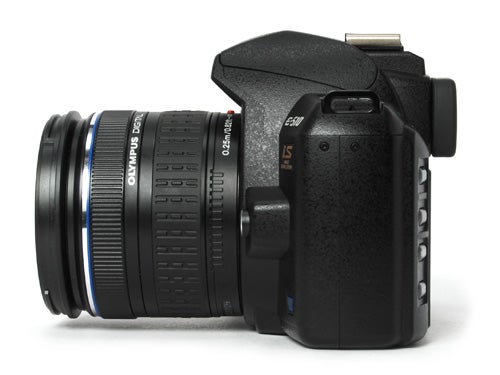
The E-510 incorporates Olympus’s CCD-shift image stabilisation system, which is extremely effective. I had no problem taking shots at the 42mm end of the kit lens zoom range (equivalent to 84mm) at 1/15th of a second hand held, which is about two-and-a-half stops below what would be safe with a non-stabilised camera. The IS system has two modes, one which damps vibration in all directions, and one which only damps up-and-down movement, for panning action shots.
Another Olympus proprietary feature is the Super-Sonic Wave Filter (SSWF) system. There is a flexible plastic filter in front of the CCD to catch dust, and when the camera it switched on this filter is vibrated at high speed to shake any dust of onto a sticky strip under the sensor, where it is trapped. I’ve not heard of any problems with this system, and I know personally that the similar anti-dust mechanism in Sony’s A100 DSLR works extremely well.
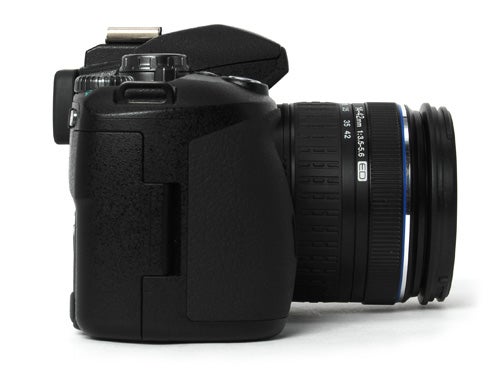
Of course the E-510’s main party trick is the live monitor view, something which Olympus pioneered on the E-330. This is more than just a novelty, and I found it very useful on occasion, especially with tripod shots, but the monitor view is quite dark compared to the viewfinder, and although there is an optional monitor gain boost for low-light use it is a bit slow and jerky. It is possible to use the monitor live view when holding the camera overhead, but why didn’t Olympus incorporate the hinged monitor from the E-330 as well? One of the things I most liked about that camera was the option to use the monitor as a waist-level finder. Unlike the E-330, the E-510 has only one mode of live view. When live view is active the AF system is disabled, so the camera doesn’t focus when you half-press the shutter button, which takes some getting used to. Instead it only focuses when you actually take the shot, flipping the reflex mirror down to use the AF, then back up to take the shot, then down when the exposure is complete, then back up again to go back to live view. This is a bit noisy, and does introduce some shutter lag, so it’s a good job it’s only an option.
Like all the Four Thirds cameras I’ve seen so far the viewfinder is a bit small and slightly darker than some, but the shooting data display on the right is nice and clear, and I had no problem with it.
The camera’s performance is exceptionally good, and an easy match for any of its rivals. Even with the SSWF system doing its thing, like most top-end DSLRs it starts up almost instantly. The AF system only has three focus points, and they are all quite close to the centre of the frame, but the system is very quick, and I had no problem at all snapping fast moving subjects. In continuous mode it can rattle off three frames a second, which combined with the fast AF makes the E-510 great for action and sports photography. In the lowest compression SHQ JPEG mode it can maintain that 3FPS shooting rate apparently until the memory card is full, and even in RAW+SHQ mode it can shoot six frames at this speed before slowing down to approximately 1FPS. That SHQ JPEG mode is especially low compression, producing file sizes averaging around 6MB, which is huge for a 10MP camera. The RAW files are also huge, averaging around 9.6MB, so if you like to shoot in RAW+SHQ mode a 1GB card is only going to be enough for 40 shots! Fortunately the E-510 has dual card slots for both CF and xD-Picture cards, so it’s theoretically possible to stuff 18GB of storage in there with currently available cards. Battery life also seems to be very good, despite the live view. The camera is powered by a large 1500mAh Li-ion battery which was still showing a full charge meter after two full days of shooting, and several hundred shots.
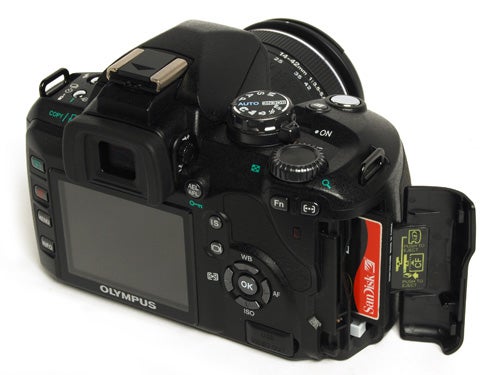
As for picture quality, see the sample shots after this review. Despite the lousy weather the E-510 turned in some fantastic shots, thanks in no small part to the outstanding kit lens, which produced pin-sharp detail from corner to corner at all focal lengths. As usual the Olympus metering system was flawless, coping with every lighting condition I tried. Noise control was also superb, with virtually no difference between shots taken at 100, 200 or 400 ISO, and minimal noise at 800. There was some noise visible at 1600 ISO, but even at the default low noise filtering it wasn’t too bad, and did not affect colour balance at all.
The Four Thirds Live MOS sensor is smaller than the APS-C sensors found in most other digital SLRs, measuring 17.3 x 13.0mm against 23.6 x 15.8mm (Nikon DX) and some people have noted that the dynamic range appears to be slightly smaller as a result of the physically smaller and more crowded photocells. I have to say that I did notice a few burned-out highlights on some pictures, but no more than I would have expected from any other camera. In terms of the level of fine detail, comparing the results directly with shots I took with the Nikon D80, the Sony Alpha A100, the Samsung GX10 (Pentax K10D) and the Canon EOS 400D, I would say that the E-510 comes in a close second to the much more expensive Nikon, although the Olympus’s test shots were taken in much worse weather conditions, with a heavy overcast and a hint of drizzle. If it manages to stop raining for half an hour sometime before I have to send the camera back I’ll re-shoot them for the sake of completeness.
”’Verdict”’
The Olympus E-series continues to get better and better. The E-510 is a superb photographer’s camera, offering superb handling, outstanding performance, a huge degree of control and first rate picture quality, in a compact and robust package and at a price which comfortably beats most of the competition. It is without question one of the best semi-pro DSLRs currently available, and a genuine pleasure to use.
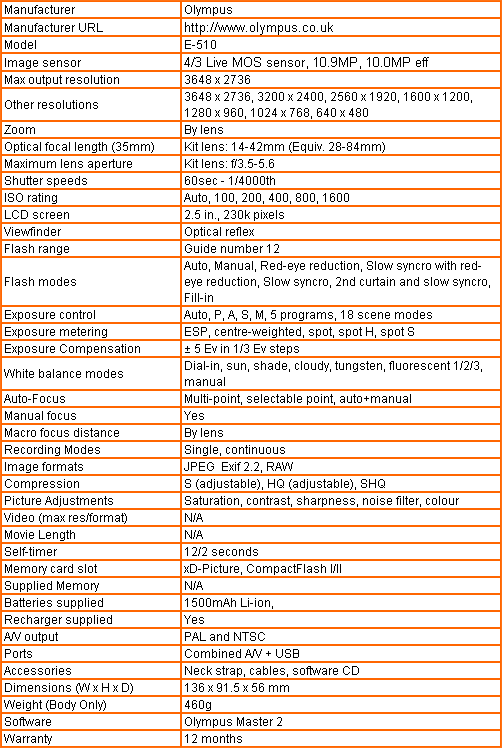
”Over the next few pages we show a range of test shots. On this page the full size image at the minimum ISO setting has been reduced to let you see the full image, and below that a series of full resolution crops have taken from original images at a range of ISO settings to show the overall image quality.”
—-
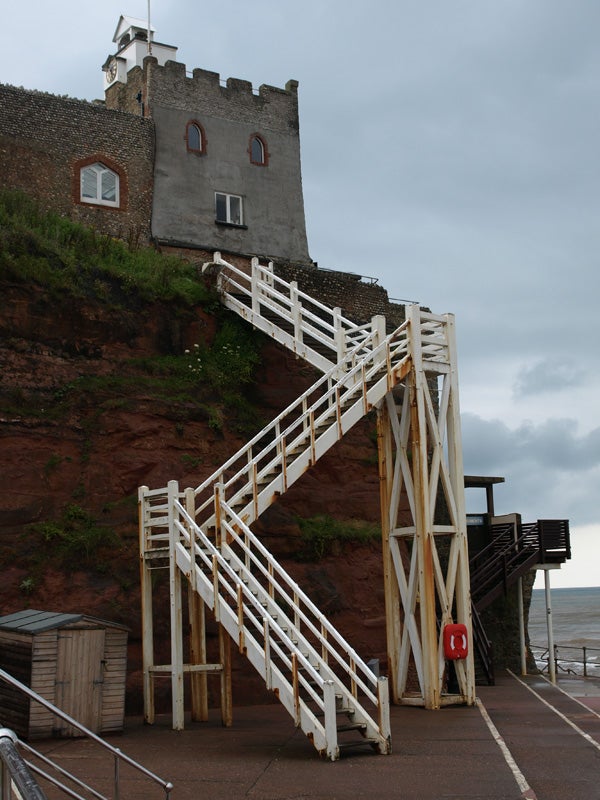
—-
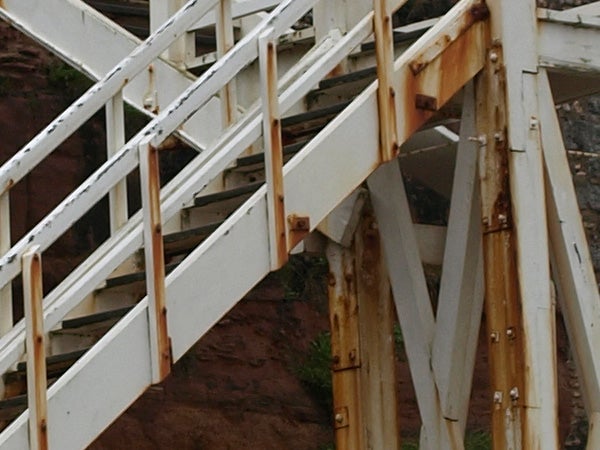
At the minimum setting of ISO 100 there is, of course, no image noise.
—-

Virtually identical at ISO 200.
—-
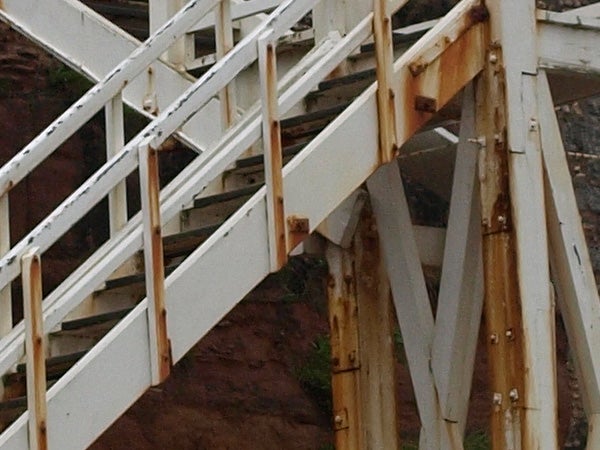
Still noise-free at ISO 400.
—-
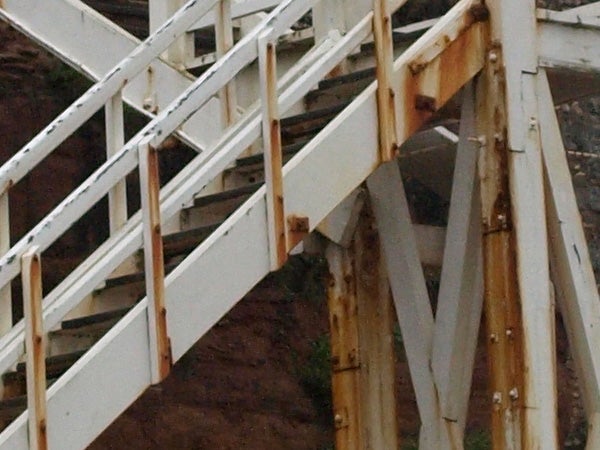
There is some visible noise at ISO 800.
—-
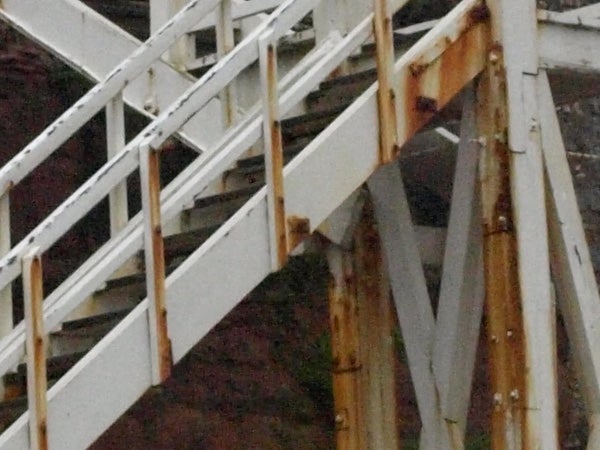
Very visible noise at ISO 1600, but not unprintable.
—-
”A range of general test shots are shown over the next two pages. In some cases, the full size image has been reduced for bandwidth purposes, and a crop taken from the original full resolution image has been placed below it to show the overall image quality. Some other pictures may be clicked to view the original full-size image.”
—-

Fortunately my usual DSLR comparison shot was the only image whose JPEG file was under 5MB, which is our download limit. Click on the image above to view it full size, or see the crop below. Compare this with similar shots from my other 10MP DSLR reviews.
—-

This is a full-res crop from the above image.
—-
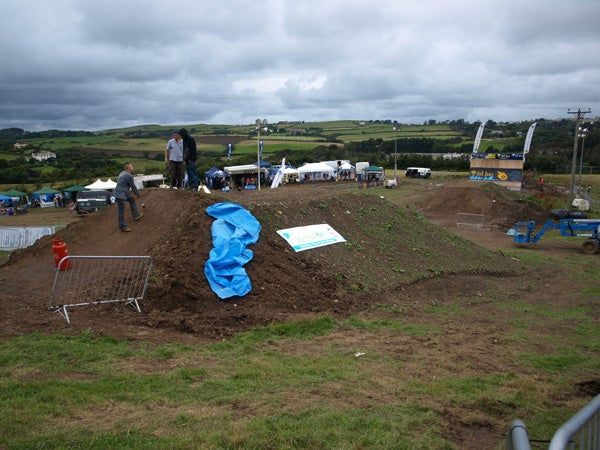
I tested the E-510 at the South West Mountain Board centre, near Bideford in Devon. They were desperately trying to dry the muddy track for a big event later that evening.
—-

This is a corner crop from the frame above, showing the sharp corner detail at wide angle.
—-

The AF system is amazingly quick, easily able to capture spur-of-the-moment action shots.
—-
”A range of general test shots are shown over the next two pages. In some cases, the full size image has been reduced for bandwidth purposes, and a crop taken from the original full resolution image has been placed below it to show the overall image quality. Some other pictures may be clicked to view the original full-size image.”
—-
This next sequence of shots was taken in continuous mode at 3fps.

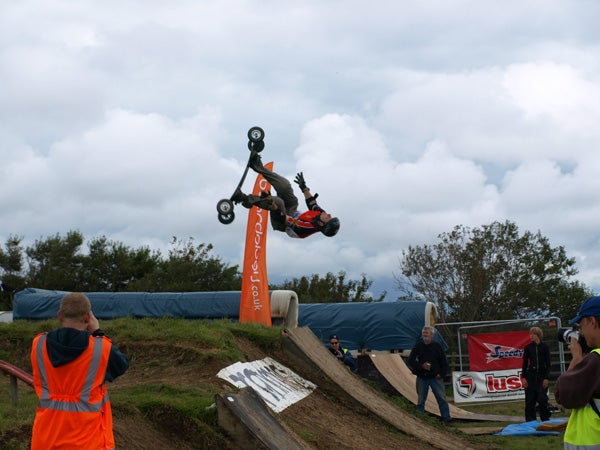
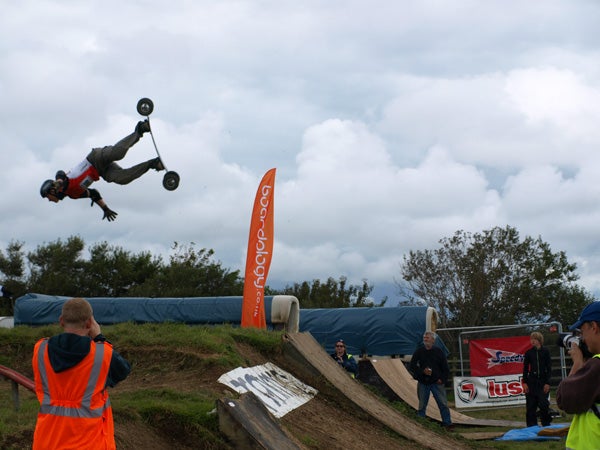
—-

These flowers would look a lot better with a bit of sunshine.
—-

The sensor copes well with high contrast, but even the fiddler looks sick of the weather.
—-
Trusted Score
Score in detail
-
Value 9
-
Image Quality 9
Features
| Camera type | Digital SLR |
| Megapixels (Megapixel) | 10 Megapixel |
| Optical Zoom (Times) | 3x |
| Image Sensor | Live MOS |
| Image Stabilisation | Optical |
| LCD Monitor | 2.5 in |
| Flash modes | Auto Flash, Red-eye Reduction, Flash OFF |
| Memory card slot | CompactFlash (CF) Card, Microdrive, xD-Picture Card |

